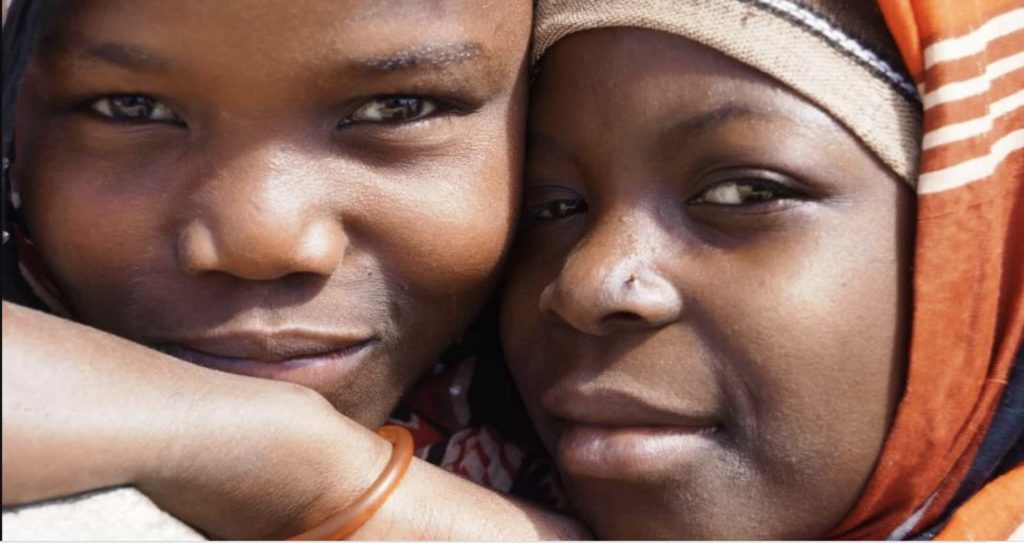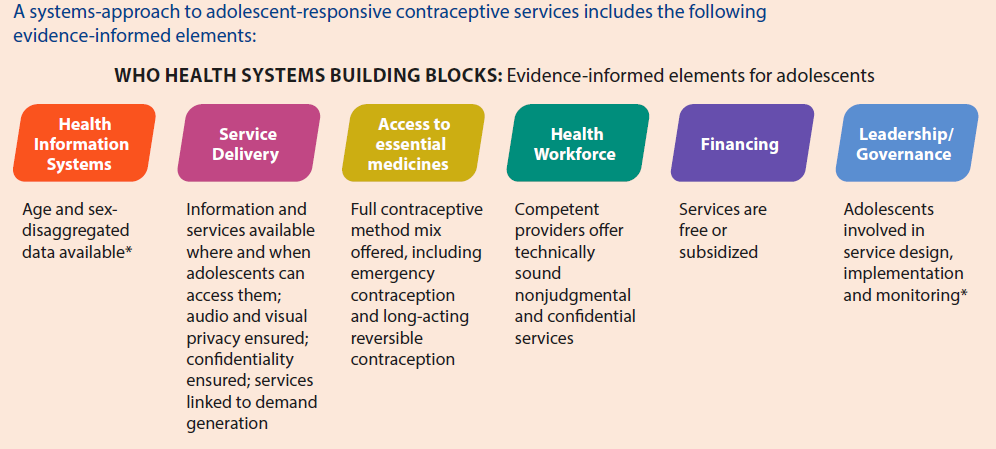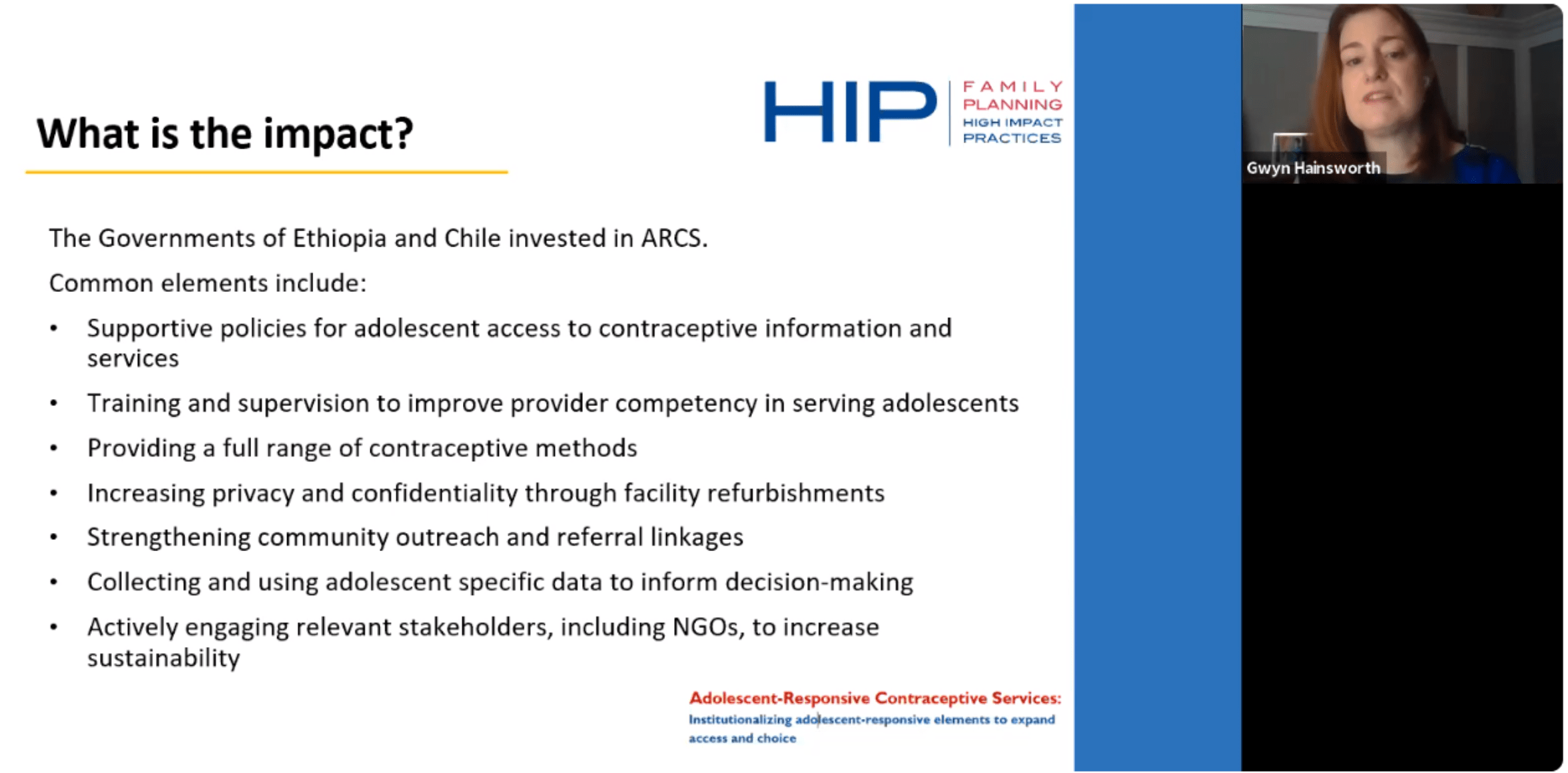Recap: Adolescent Responsive Services in Family Planning
A Health Systems Perspective

On March 16, the NextGen RH CoP, Knowledge SUCCESS, E2A, FP2030, and IBP hosted a webinar, “Adolescent Family Planning and Sexual and Reproductive Health: A Health Systems Perspective,” that explored the updated High Impact Practice (HIP) brief on Adolescent Responsive Services. Brendan Hayes, Senior Health Specialist at the Global Financing Facility; Aditi Mukherji, Policy Engagement Coordinator at the YP Foundation India; Yvan N’gadi Youth Ambassador for the Ouagadougou Partnership; and Bentoe Tehoungue, Director of the Family Health Division at the Ministry of Health in Liberia joined moderator Dr. Venkatraman Chandra-Mouli of the WHO’s Department of Sexual and Reproductive Health & Research at the WHO for a discussion on the shift to an adolescent responsive health systems approach. Gwyn Hainsworth from the Gates Foundation provided an overview of the key updates included in the HIP brief, and Dr. Meseret Zelalem and Mat. Juan Herrara Burott and Soc. Pamela Meneses Cordero from the Ministries of Health in Ethiopia and Chile, respectively, presented their country’s experiences implementing a health systems approach to AYRH.
Missed this webinar? Read the summary below or access the recordings.
Want just the highlights? Jump to key takeaways from the speakers.
Panel Discussion
What are some challenges to implementing a health systems approach for adolescent responsive services, and how are we working to overcome them?
The panelists began by discussing challenges to implementing a health systems approach and how they have overcome them. Ms. Tehoungue discussed the importance of involving adolescents and youth in strategies to implement responsive services—to ensure that adolescents are involved in care, and able to monitor and evaluate whether strategies are working well. She added that coordination among government stakeholders and implementing partner organizations is crucial for ensuring that strategies and funding are aligned with government priorities. She emphasized that ensuring continued country-level funding was essential for sustaining systematic approaches to Adolescent and Youth Reproductive Health (AYRH). Mr. Hayes added that, while there will always be room for experimentation in programming strategies, that experimentation will likely happen outside of national health systems. It is critical for governments to play a stewardship role and be able to think into the future to ensure new programming strategies are integrated into the national health system, scaled up, and financed.
How can we ensure alignment among programs and initiatives without stifling the creativity and innovation of the NGO community?
Aditi Mukherji mentioned that involving non-governmental organizations (NGOs) in coordination—while recognizing that there are multiple layers of stakeholders that need to be involved in any ideation on policies related to AYRH—is needed to ensure alignment without hindering the creativity of local NGOs. She stated that while funding can be a challenge, it is not only the lack of funds that presents difficulties; it could also be a lack of using existing funding in the most effective and impactful way.
How can we meaningfully integrate youth voices at the national level?
Yvan N’gadi discussed how a regional partnership, such as the Ouagadougou Partnership, can facilitate NGO involvement in policy and governance related to adolescent responsive services by providing an established forum to engage youth leaders as national plans are developed. He highlighted the importance of developing capacity for youth to not only participate in these spaces, but also effectively advocate for AYRH—helping them understand plans related to AYRH and the audience of policymakers and stakeholders in a particular country. He mentioned that even with an established space to engage youth leaders at a local level, it is still uncommon to see change in how the rights of adolescents and young people to quality health care are being met. Brendan Hayes expanded on Mr. N’gadi’s comments and mentioned how important extending youth involvement beyond planning and strategy to other conversations including national insurance planning. Ms. Tehoungue added that engaging and empowering youth in leadership roles for AYRH programming has led to greater successes and will help to ensure continued progress over time.
How can we meaningfully engage adolescents and youth in social accountability mechanisms for adolescent responsive services?
Ms. Mukherji mentioned that the YP Foundation through its Policy Working Group (a national youth-led network of young people across India) is engaged in advocacy efforts to address a lack of institutionalized roles for young people in policymaking. The group strives to position young people as credible representatives of organizations working in the field of AYRH who are capable of providing important insight. The group also advocates for the benefits of institutionalized roles for young people versus piecemeal participation in policymaking processes. Ms. Tehoungue shared that in Liberia, youth leaders are forming civil society organizations (CSOs) and taking part in public discussions to hold policymakers accountable for the commitments they are making to young people.
How can we move forward in implementing adolescent responsive services within the health system?
Mr. Hayes outlined three important areas to focus on as we move forward in implementing adolescent responsive services. These include:
- Cost: There are gaps in the evidence base on adolescent health programs and cost effectiveness. However, this is only part of the challenge. Understanding cost effectiveness and thinking critically about stark fiscal constraints that countries are experiencing, especially during the pandemic, is important to determine which programs are realistically able to be scaled up. Extremely limited fiscal resources mean things can be cost-effective, but not necessarily affordable.
- Complexity: We need to address the complexity of adolescent health issues and programs. These include behavioral and economic determinants of health and multi-sectoral strategies. Complexity is always a challenge to scale, and we must weigh the trade-offs between complexity and the size of the programs and activities being implemented.
- Measurement: We are missing reliable instruments for measuring the quality of implementation of adolescent and youth health programs, including AYRH programs, and the experience adolescents and young people have with care within health systems. In order to effectively leverage health systems for adolescent responsive services, we must have reliable and consistent data to guide our efforts.
Presentation of Key Changes in the Updated HIP Brief
On behalf of the other HIP authors, Gwyn Hainsworth (Senior Program Officer, Bill & Melinda Gates Foundation) shared key aspects of the newly released HIP Enhancement, Adolescent-Responsive Contraceptive Services: Institutionalizing Adolescent-responsive Elements to Expand Access and Choice. This brief offers practical ways to implement adolescent responsive services. The other HP authors are Cate Lane (Director for Adolescents and Youth, FP2030), Jill Gay (Chief Technical Officer, What Works Association), Aditi Mukherji (Policy Engagement Coordinator, YP Foundation India), Katie Chau (Independent Consultant), Lynn Heinish (Independent Consultant), and Dr. Venkatraman Chandra-Mouli (Scientist leading Adolescent Sexual & Reproductive Health, Department of Sexual and Reproductive Health & Research, WHO).
How to provide adolescent responsive services through health system building blocks
Ms. Hainsworth highlighted how adolescent responsive services can be broken down by health systems building blocks, including disaggregated data by age (health information systems); meaningful involvement of adolescents in design, implementation, and monitoring of adolescent services (leadership/governance); and provision of services to adolescents and youth by trained providers (health workforce).

Common elements of successful ARS investment and the impact on contraceptive use among adolescents
Ms. Hainsworth emphasized the impact that is possible by investing in an ARS approach, including an increase in contraceptive use among adolescents and young people. Both Ethiopia and Chile have seen significant increases in contraceptive uptake among adolescents aged 15-19 years old. She also outlined common elements of the ARS investment in Chile and Ethiopia, such as training and supervision to improve provider competency in serving adolescents and collecting and using adolescent-specific data to inform decision-making.

Tips for Implementation
Ms. Hainsworth highlighted key tips for implementation included in the brief:
- Ensure an enabling policy and legal environment for contraceptive provision to adolescents regardless of marital status or parity (Health Systems Building Blocks: service delivery, access to essential medicines, leadership & governance)
- Employ a variety of sectors and channels to reach different adolescent segments (service delivery)
- Link adolescent responsive contraceptive services (ARCS) with social and behavior change interventions that address adolescent-specific cognitive, cultural, and social challenges and barriers (service delivery)
- Improve providers’ competency in providing ARCS (health workforce)
- Collect and use data to design, improve, and track ARCS implementation (health information systems)
- Address financial barriers to adolescent contraceptive use, especially as countries launch their universal health coverage (UHC) plans. (financing)
- Support meaningful participation and leadership of adolescents and recognize the right of adolescents and young people to meaningfully engage in the design, implementation, and monitoring of ARS. (leadership and governance)
Measurement Indicators for Adolescent Responsive Services
Ms. Hainsworth mentioned three measurement indicators, including the number of health facilities that provide adolescent contraceptive services, the total number of contraceptive visits by clients under the age of 30, and the proportion of districts (or other geographic areas) in which adolescents (15-19 years old) have a designated place in community accountability mechanisms on access and quality of health services. She emphasized that the first two indicators should be collected and analyzed together for a more robust look at how well adolescents are being reached by services.
Case Studies from Ethiopia and Chile
Dr. Meseret Zelalem from the Ministry of Health (MOH) in Ethiopia and Mat. Juan Herrara Burott and Soc. Pamela Meneses Cordero from the Ministries of Health in Chile provided brief presentations on the implementation strategies their respective countries have used to ensure adolescent responsive services.
Ethiopia
Deciding to focus on AYRH due to adolescent and youth pregnancy rates contributing greatly to the number of maternal deaths, Ethiopia has implemented comprehensive strategies at the health systems level to increase the met need for family planning among adolescents and youth. Highlights of their strategies include:
- Health policies at the national level that enable access to contraceptives for adolescents and mandate that they be provided free of charge at government facilities and expanded service outlets;
- Increasing the competency of the health workforce in AYRH by developing and implementing extensive training materials;
- Implementing data and measurement indicators to ensure disaggregation and robust monitoring and evaluation of AYRH strategies; and
- Ensuring the meaningful engagement of adolescents and youth by developing a Youth Engagement Guideline, and including youth-led organizations in the national adolescent and youth technical working group.
Chile
Approximately 80 percent of the adolescent population in Chile receives services through the public health system, and the MOH has implemented comprehensive strategies to help ensure that services are responsive and meet the needs of adolescents and youth. Highlights of their strategies include:
- Supportive policies and laws that facilitate focused programming on AYSRH and enabling environments to receive AYSRH services;
- Improving the competency of their health workforce in AYSRH by developing and implementing trainings focused on laws and policies related to AYSRH, an integrated health model of services, the provision of long-acting reversible contraceptives (LARCs), and quality SRH counseling;
- Implementing data and measurement indicators to ensure disaggregation by age range, native populations, and migrant populations; and
- Ensuring meaningful youth engagement through the creation of an Adolescent and Youth Advisory Council, which features two adolescent or youth members from each of the country’s 16 regions. This advisory council is a part of the National Civil Society Council at the MOH.
Questions & Answers
The webinar ended with a Q&A period that included questions on gender equality, implementing ARS in humanitarian settings, specific questions on including men and boys in AYRH services in Chile and national budgets for AYRH in Liberia.
Read more about the questions answered in the Q&A box during the webinar.
Key Takeaways from the Speakers
Bentoe Tehoungue
Ms. Tehoungue shared that “cost effective” does not necessarily mean “affordable” or “available.” She mentioned that implementation is often done in high-population areas, which limits effectiveness and excludes other people who need services just as much.
Yvan N’gadi
Mr. N’gadi mentioned that including youth in the planning and implementation process is important. The issue of the place of adolescents at the table is critical, but we especially need to contextualize family planning and contraceptive use in the lives of adolescents and young people. This has been exacerbated by COVID-19 in West Africa.
Aditi Mukherji
Ms. Mukherji took away the comment that we are missing quality measuring tools, and that this is an effect of not involving adolescents and young people in the process of policymaking. She commented that we could solve this by creating better feedback tools and accountability mechanisms and give young people a seat at the table.
Brendan Hayes
Mr. Hayes expressed optimism for the field of AYRH, and that despite challenges, we are headed in the right direction. He mentioned that we have never seen AYRH be more relevant in the discussions with policymakers than we are today, and that there is a window of opportunity for advancing investment in this area
Gwyn Hainsworth
Gwyn mentioned that the use of data to understand not only who we are reaching but who we aren’t reaching is critical for ensuring equity in service access and quality and taking corrective action when there are gaps. An adaptive management approach is essential to anticipate and quickly address gaps or barriers to access or quality of AYRH services and mitigate potential negative consequences, especially during health emergencies such as the COVID-19 pandemic.
Dr. Meseret Zelalem
Dr. Zelalem mentioned a few key points as we move forward in implementing ARS. These include improving and expanding the responsiveness of the system by using data for action, employing the use of digital tools, addressing gaps in unmet need for contraception, and ensuring meaningful youth engagement. Adolescent responsive health systems should increase information and access to not only AYRH, but also other health areas such as nutrition and mental health.
Mat. Juan Herrara Burott and Soc. Pamela Meneses Cordero
Both Mat. Herrara Burott and Soc. Meneses Cordero mentioned the importance of a focused strategy for ensuring that adolescent services are responsive, including using disaggregated data to effectively guide approaches and address gaps, ensuring meaningful youth engagement not only in adolescent and youth health areas, but other health areas as well, and ensuring the health workforce is trained not only in clinical service provision, but that they also understand the social and legal context of the country that supports AYSRH, and the determinants of adolescent and youth health behavior.
Dr. Venkatraman Chandra-Mouli
Dr. Chandra-Mouli outlined three detailed takeaways from the webinar:
- Recognizing the need to engage with health systems strengthening and scale up to reach adolescents;
- Highlighting the challenges that still persist in ensuring that adolescents and youth are meaningfully engaged, and what is being done to actively improve these areas; and
- Leading with accountability mechanisms, coordination, and governance. There is a clear path forward laid out in the HIP Enhancement brief, and other health systems will benefit from adapting Chile and Ethiopia’s experiences in implementing ARS and measuring its impact on the health of adolescents and young people.





